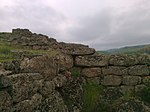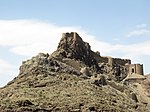Zibad Castle
This article may be a rough translation from another language. It may have been generated, in whole or in part, by a computer or by a translator without dual proficiency. |
| Zibad Castle | |
|---|---|
| Gonabad | |
 | |
| Coordinates | 34°16′35″N 58°29′15″E / 34.27639°N 58.48750°E |
| Grid reference | grid reference TQ785256 |
| Site information | |
| Owner | National heritage Iran |
| Condition | Ruins |
| Site history | |
| Built by | Sasanian Empire |
| Materials | Sandscript stone |
| Demolished | Post in War |
| Battles/wars | Davazdah Rokh and Nizak tarkhan |


Zibad Castle is one of the four historical monuments of Zibad, Iran. In 2001, the castle was registered as a national property in Iran, which is related to the history of pre-Islamic Iran, and is located in Gonabad city, Kakhk district, in the residential area of Zibad. It has been registered as national heritage. In addition to the castle of Zibad, there are also the royal castle of Zibad nationally registered under the name of Shahab Castle in 2002.
Last shelter of the last Persian emperor
Yazdegerd III some historian had wrote After his defeat, he sought refuge at a miller near Marv , who, however, murdered in 651. the miller had reportedly killed Yazdegerd in order to obtain his jewelry,[1] whilst the Cambridge History of Iran states that the miller was sent by Mahoe Suri.[2] According to the history of Belazari, Yazdegerd III was defeated in a war in province of Merv in the city of Gonabad. Nizak the army chief of Mahoe Suri in the Gonabad and according to the new research the war occurred in zibad of gonabad. Regardless, the death of Yazdegerd marked the end of the Sasanian Empire, and made it less difficult for the Arabs to conquer the rest of Iran. All of Khorasan was soon conquered by the Arabs, who would use it as a base to attack Transoxiana.[1] The death of Yazdegerd thus marked the end of the last pre-Islamic Iranian empire after more than 400 years of rule. An empire–which had a generation earlier briefly conquered Egypt and Asia Minor, even reaching as a far as Constantinople, fell to a force of lightly equipped Arabs that were used to skirmishes and desert warfare. The heavy Sasanian cavalry was too sluggish and systematized to contain them; employed light-armed Arab or East Iranian mercenaries from Khorasan and Transoxiana would have been much more successful.[3]
Several different and contradictory narratives about the death of Yazdgerd III have been left in historical books. According to the excavations of Zibd-Gonabad Fortress and according to oral narrations and the report of Blazeri and Habib Abdolhai, Dr Ajam and Abas Zmani(historical study magazin 1974) it seems that the narration related to the murder of Yazdgerd in Merw Mill is more mythical than the truth and what is closer to the truth is the narration of Al-Baladhuri in Kitab Futuh al-Buldan. that Yazdgerd was killed in Gonabad .The main text of Blazeri's book The Fate of Yazdgerd III:
Then he went to Khorasan, then he went to Janabad (Gonabad) he was welcomed and ruler of Merv send Nizak Trkhan to welcome him in Gonabad. but after weeks he asked the emperor to marry his daughter and the emperor refused and this caused a war and at the end Nizak attacked and defeated the king army and Destroyed and captured the remnants of the imperial forces. the battle was occurred in zibad gonabad.[4]
Mahoe was probably from the House of Suren, one of the seven Parthian clans of the Sasanian state.[2] During the Islamic invasion of Iran, Yazdegerd III went to refuge in Marv; in his way to Merv he stayed in Gonabad Mahoe envoy warmly received them in Gonabad.[5] Mahoe used opportunity to secretly plot with the Hephthalite ruler Nizak against Yazdegerd.[2]
Sufeh Pir
Sufeh Pir is a cave believe to be the tomb of Piran Viseh in the Kūh-Zibad mountain. He is a Turanian figure in Shahnameh, the national epic of Greater Iran. Beside Shahnameh, Piran is also mentioned in other sources such as Tabari and Tha'ālibī. He is the king of Khotan and the spahbed of Afrasiab, the king of Turan.
According to the book of Dr Abas Zamani Piran Viseh was buried in the cave of Sofe Zibad now called DarSufa Pir. [1]
See also
References
- ^ a b Kia 2016, p. 285.
- ^ a b c Zarrinkub 1975, p. 25.
- ^ Shahbazi 1986, pp. 489–499.
- ^ فتوحالبلدان،Al-Baladhuri in Kitab Futuh al-Buldan p569 صص ۵۶۸–۵۶۹
- ^ Pourshariati 2008, pp. 261–262.
Sources
- Zarrinkub, Abd al-Husain (1975). "The Arab conquest of Iran and its aftermath". The Cambridge History of Iran, Volume 4: From the Arab Invasion to the Saljuqs. Cambridge: Cambridge University Press. pp. 1–57. ISBN 978-0-521-20093-6.
- Pourshariati, Parvaneh (2008). Decline and Fall of the Sasanian Empire: The Sasanian-Parthian Confederacy and the Arab Conquest of Iran. London and New York: I.B. Tauris. ISBN 978-1-84511-645-3.
- Kia, Mehrdad (2016). The Persian Empire: A Historical Encyclopedia [2 volumes]: A Historical Encyclopedia. ABC-CLIO. ISBN 978-1610693912.
- Shahbazi, A. Shapur (1986). "Army i. Pre-Islamic Iran". Encyclopaedia Iranica, Vol. II, Fasc. 5. London et al. pp. 489–499.
{{cite encyclopedia}}: CS1 maint: location missing publisher (link) - Morony, M. (1986). "ʿARAB ii. Arab conquest of Iran". Encyclopaedia Iranica, Vol. II, Fasc. 2. pp. 203–210.
- Report of a Persian magazine
- Castle of Shah Nesheen Zibad
- Dr Ajam, Geography of the 12 Rokh War in Zibad Gonabad, Mashahd University Magazine Simorgh No9 year9. 953942 شابک ۹۵۳۹۴۲
- 3 historical Places in Zibad. Persian book
- Geography of Gonabad
- Pangereh Magazine 2012 Castle of Zeibad by Dr Ajam[dead link]
- Photo of the castle
- Zibad history by Dr Ajam
- shahname/12rokh war
- Book by Dr Zamani and Ajam 1972 no 41 magazine
- Article in Persian language. Parssea magazine, 2011
- Geography and tribe and minority in Khorasan, Mohammad Ajam, research published 1992, University of Imam Sadegh, Tehran.
Gallery
-
Zibad Castle زیبد
-
Zibad Castle قلعه زیبد
-
Zibad Rheum
-
Kariz Zebad
-
zibad Mountain
-
Ferula Zibad
-
Sassanian Castel
-
Soufe Zibad
-
Rivas zibad
-
Kūh-ZibadZibad Gonabad
-
A photograph of Yaldā Night.]]
-
Ancient water clock used in qanat of gonabad 2500 years ago
-
Reconstruction of the scene with a real manager of the water clock, Iran










































